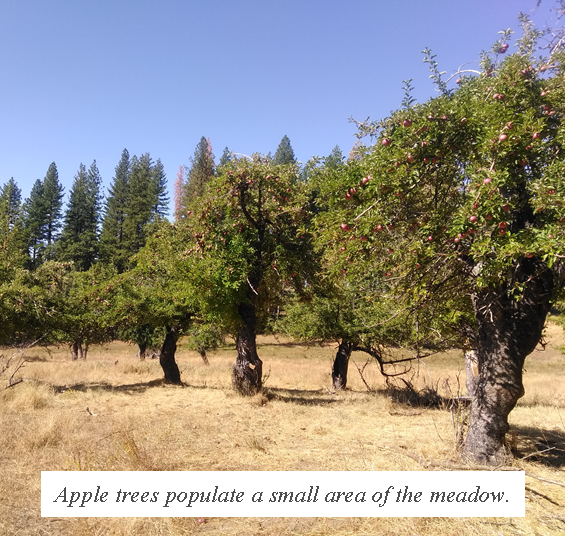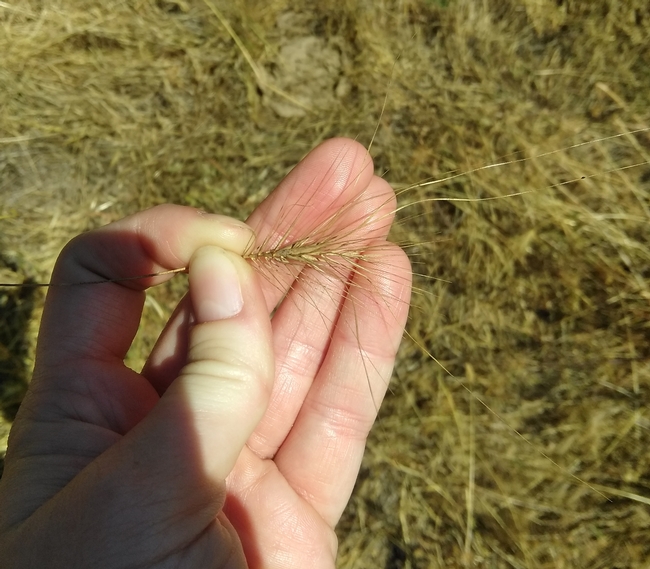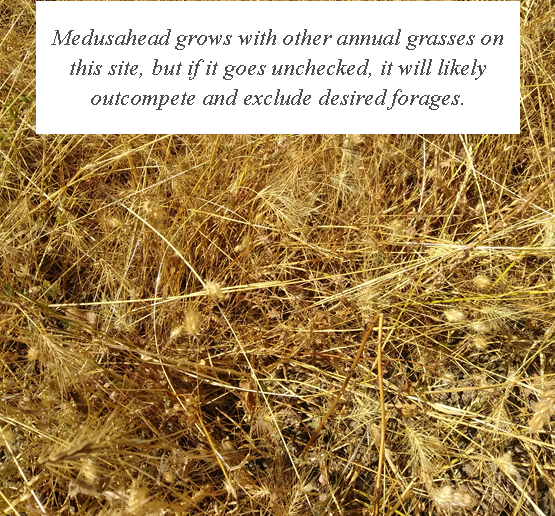Many factors make weed management on federal public lands an interesting challenge.
In September I was invited to join one of the Sierra National Forest Rangeland Management Specialists to explore a medusahead infestation in one of the grazing allotments she manages. The infested meadow used to be a homestead, though the only obvious reminder is the cluster of still-productive apple trees in the middle of an otherwise grass-dominated site. Pines and other conifers border the meadow, and a forest road divides the meadow into two parts. The portion uphill of the road is steeper and has more trees interspersed with the herbaceous vegetation, while the downhill portion is a more expansive, gentler sloping meadow. Due to the elevation, a variety of broadleaved (forb) species were still green, but the medusahead and other annual grasses were long since brown. Springs throughout the area supported green forbs, rushes and sedges.
During the site visit, the specialist wanted to brainstorm ideas for how to reduce the medusahead population. The primary management tools being considered are targeted grazing and prescribed burning. Since the meadow is already grazed, one of the big hurdles to targeted grazing – finding animals to do the job – is reduced. However, concentrating the animals in the area to graze the medusahead more intensively than normal will require additional infrastructure. We discussed the potential for temporary or permanent cross-fencing, to keep an appropriate number of cows in the target area for a specified time frame. For reference, during the 2017 grazing season there were about 66 acres of forest, meadows, and everything in between for each cow in Sierra National forest grazing allotments. By contrast, this meadow is less than 50 acres, and the goal would be to have enough cattle confined to the meadow for a given grazing period so that the cows actually eat the medusahead before it produces seed.
We also discussed the variability of the vegetation in the meadow – from the apple “orchard”, to miniature wetlands, to annual grassland types. Without any additional incentives, the cattle are likely to stay close to the areas with the most resources: the existing water trough, the shade of the apple trees, and the lushest patches of forage. Strategic mineral or protein supplementation, or a secondary water development could attract the cattle to the densest patches of medusahead and away from the springs where no medusahead is growing.
Grazing makes the most sense as a control method on the downhill, larger meadow area. However, the specialist noted that the uphill, smaller meadow area could be a good candidate for a prescribed burn. On the uphill patch, there are more trees and less forage; it would be harder to fence due to the topography (and thus harder to keep the cows on the medusahead); there isn't a developed livestock watering source uphill of the road; and the Forest Service already has plans to burn the neighboring areas this fall and winter. In essence, grazing would be hard to implement, but the protective nature of the neighboring burns would mean a prescribed fire could be feasible under the right conditions.
Before any of our brainstormed ideas can be implemented the specialist must do several things. First, she needs to consult with the cattle owner who grazes the area, to see if they are willing and able to install the necessary fencing. Forest Service grazing allotment permittees are expected to maintain the grazing infrastructure on the allotments they graze, so the rancher is on the hook for installing a new fence if they decide to move forward with the targeted grazing plan. This is a huge benefit to the Forest Service – the maintenance and infrastructure that permitted ranchers provide on grazing allotments would otherwise cost the Forest Service thousands of dollars and many employee hours per allotment per year.
Even if the rancher is on board with the project, additional Forest Service requirements make projects slow to implement. National Forests are multi-use landscapes, which means that there are many potential uses which all must be considered when implementing a project. Uses of Sierra National Forest include recreation, grazing, and wildlife habitat. As such, all proposed projects must undergo environmental evaluation to ensure any environmental concerns are identified and mitigated or resolved. Even for a project like the potential targeted grazing – which uses a land management tool that has previously been approved on the meadow, just at a different intensity – the site will have to be evaluated. If all goes smoothly, the range management specialist hopes to begin with the grazing plan once the allotments open for grazing next year.
As you can imagine, weed control on federal public lands can be quite a challenge – even if a project is approved, it may be months after the original proposal, and some management tools may not even be options to begin with if the public opposes their use. I hope to be able to share a success story about this plan being implemented by this time next year, and will follow with observations of the results as available.
This article was originally posted on the UC Weed Science blog.


